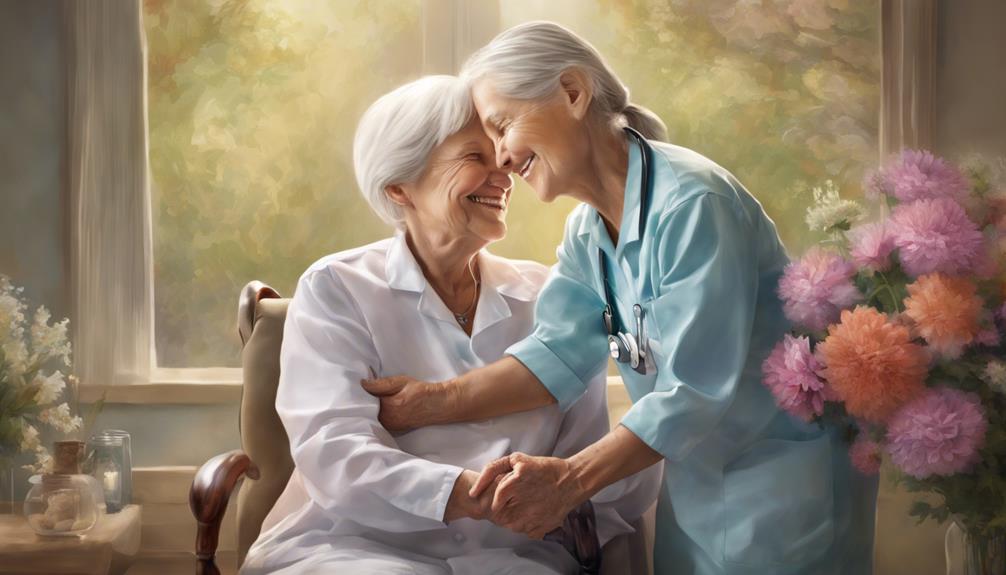Finding the right balance between comfort and functionality is crucial when it comes to navigating the intersection of hearing aids and eyeglasses.
Have you ever wondered how to strike the perfect balance between these essential accessories?
Well, let's uncover the secrets to harmoniously wearing hearing aids with glasses.
Key Takeaways
- Choose behind-the-ear aids for comfort with glasses frames
- Opt for thin wire earpieces for BTE aids and glasses compatibility
- Consider receiver-in-the-canal aids for discreet amplification
- Seek expert advice for seamless integration and optimal performance
Choosing the Right Hearing Aid Model
When selecting a hearing aid model, it's essential to consider factors such as the degree of hearing loss, personal style preferences, and comfort with wearing glasses. For individuals with moderate to severe hearing loss who wear glasses, a behind-the-ear (BTE) hearing aid may be the most suitable option. BTE hearing aids are popular for their effectiveness and comfort, making them a practical choice for those needing stronger amplification.
One advantage of BTE hearing aids for individuals who wear glasses is their design, as the main body of the device rests behind the ear rather than inside the ear canal. This feature prevents interference with the frames of glasses, ensuring a comfortable fit. However, it's important to note that adjustments may be necessary to accommodate both the hearing aid and glasses properly. By choosing a BTE model, individuals can find a balance between addressing their hearing needs and maintaining comfort while wearing glasses.
Tips for Wearing Behind-the-Ear Aids

To optimize comfort and functionality when wearing behind-the-ear aids with glasses, consider selecting glasses with thin wire earpieces to create more space for a seamless fit. The thin wire earpieces allow the hearing aid to sit snugly behind the ear without interference from bulky frames.
When putting on glasses, it's advisable to do so before fitting the BTE aid. This sequence helps in proper positioning of both the glasses and the hearing aid, ensuring a comfortable experience throughout the day. Adjusting both the glasses and hearing aid is essential to guarantee they sit securely and comfortably together.
Additionally, when removing glasses, do so carefully and avoid pulling them off haphazardly to prevent accidentally dislodging the BTE aid. By following these tips, individuals can enjoy wearing their behind-the-ear aids with glasses without compromising on comfort or functionality, enhancing their overall hearing experience.
Using Receiver-in-the-Canal Aids
Receiver-in-the-Canal (RIC) aids offer a discreet and comfortable solution for individuals seeking effective amplification while wearing glasses. These aids feature a small casing behind the ear, making them compatible with glasses without causing discomfort.
The receiver of RIC aids is placed in the ear canal, minimizing any interference with the earpieces of glasses, allowing for a more seamless experience. RIC aids are designed to cater to varying power levels, making them suitable for individuals with mild to severe hearing loss.
Their ability to provide effective amplification while maintaining a comfortable fit has made them a popular choice for those looking for a discreet hearing aid option that works well with glasses. The combination of advanced technology, compatibility with glasses, and a comfortable design makes receiver-in-the-canal aids a practical choice for individuals seeking a reliable hearing solution.
Wearing Inside-The-Ear Aids With Glasses

For those seeking a discreet and comfortable hearing solution that pairs seamlessly with glasses, Inside-The-Ear (ITE) aids offer a custom-fit option designed to cater to mild to moderate hearing loss. ITE aids are custom-made to fit within the ear canal, making them compatible with most glasses styles. Here are some key points to consider when wearing Inside-The-Ear aids with glasses:
- Thin wire earpieces: ITE aids typically have thin wire earpieces that sit behind the ear, ensuring they don't interfere with the arms or frames of your glasses.
- Comfortable fit: These aids are less visible and offer a comfortable fit, making it possible to wear them throughout the day without any discomfort.
- Convenience: ITE aids are easy to insert and remove, providing convenience for individuals who wear glasses.
- Discreet design: The discreet design of ITE aids makes them a suitable option for those looking for a subtle hearing aid solution.
- Optimal performance: Proper fitting and adjustment by an audiologist ensure that ITE aids perform optimally when worn with glasses.
Seeking Help From Hearing Experts
When seeking assistance from hearing experts, individuals can benefit from tailored guidance and support in selecting the most suitable hearing aids for their specific needs. Hearing specialists, such as audiologists, offer invaluable expertise in aiding individuals to wear hearing aids with glasses comfortably and effectively. These professionals provide assistance during the getting used phase, recommending adjustments for a seamless integration of hearing aids and glasses. Moreover, they can suggest practices in front of mirrors to improve the ease of use. Consultations with audiologists ensure that the technology in both hearing aids and glasses is optimized for connectivity, enhancing the overall experience. Additionally, hearing experts can advise on proper maintenance and care routines to prolong the performance and lifespan of both aids and glasses. Below is a table summarizing the benefits of seeking help from hearing experts:
| Benefits of Seeking Help from Hearing Experts |
|---|
| Tailored guidance in selecting suitable hearing aids |
| Support during the getting used phase |
| Recommendations for seamless integration with glasses |
| Advice on maintenance and care routines for optimal performance |
Frequently Asked Questions
What Goes on First Glasses or Hearing Aids?
When deciding what to put on first between glasses and hearing aids, we recommend starting with your glasses. This sequence ensures a comfortable fit and minimizes adjustments later.
By wearing glasses before hearing aids, you create a smooth experience for both devices. This simple routine can enhance comfort and prevent any discomfort or misplacement issues.
Do Glasses Go Inside or Outside Hearing Aids?
When wearing glasses with hearing aids, it's important to place the glasses outside the behind-the-ear (BTE) hearing aids for comfort and proper fit. Avoid placing the glasses inside the hearing aids as it can be uncomfortable and affect device effectiveness.
Ensure the earpiece of the glasses sits comfortably over the hearing aid without pressing on it. Adjusting the position of both devices is crucial for optimal functionality and comfort.
Consult audiologists for guidance on correct placement.
What Kind of Mask Should I Wear With Hearing Aids and Glasses?
What kind of mask should we wear with hearing aids and glasses?
Opt for masks with adjustable ear loops, a flexible nose bridge, and soft, breathable materials to ensure comfort with both devices. Consider clear panel masks for improved communication.
Make sure the mask fits securely without tugging on hearing aids or causing discomfort with glasses.
Choosing the right mask can enhance our experience wearing hearing aids and glasses simultaneously.
What Are Glasses and Hearing Aids Called?
When glasses and hearing aids are worn together, they're commonly referred to as 'dual-use devices.' This combination can greatly enhance the quality of life for individuals with vision and hearing impairments.
Dual-use devices like glasses and hearing aids are designed to improve communication, mobility, and overall well-being. Advancements in technology have made it easier to integrate these devices seamlessly for a more comfortable experience.
The process of fitting both hearing aids and glasses optimally is sometimes referred to as 'bimodal fitting.'
Conclusion
In conclusion, selecting the right hearing aid model, adjusting behind-the-ear aids, using receiver-in-the-canal aids, and wearing inside-the-ear aids with glasses can all enhance your hearing experience.
Remember, seeking help from hearing experts is crucial for optimal comfort and performance. By following these tips and seeking professional guidance, you can seamlessly integrate hearing aids with glasses for improved hearing clarity and comfort.
Don't hesitate to prioritize your hearing health for a better quality of life.









